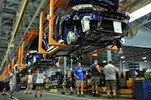
Ford released initial details on a new plan to expand its manufacturing capabilities and boost global production on the 100th anniversary of the moving assembly line developed under the leadership of the brand's founder, Henry Ford .
By 2017, the U.S. automaker wants to produce on average four different models at each plant around the world in order to increase adaptability based on customer demand.
Ford also wants 90 percent of its plants around the world to run on a three-shift or crew model by 2017, which will help increase production more than 30 percent. In the same year, virtually all Ford vehicles will be built off nine core platforms in order to boost efficiency. Today, Ford builds cars on 15 different platforms.
The automaker says that its recent expansions in global manufacturing and production have helped to retain 130,000 hourly and salaried jobs around the world. They also contributed to Ford being on track to produce 6 million vehicles this year – that’s about 16 vehicles every 60 seconds around the world.
These announcements were made on the same day that, one hundred years ago, Henry Ford and his team at Highland Park assembly plant launched the first moving assembly line. The invention simplified assembly of the Ford Model T ’s 3,000 parts by breaking it into 84 distinct steps performed by groups of workers as a rope pulled the vehicle chassis down the line.
Thanks to the new process, the assembly time for a single vehicle dropped from 12 hours to about 90 minutes. This allowed Ford to reduce the price of the Model T from $850 to less than $300, making it affordable for the masses. Eventually, Ford built a Model T every 24 seconds and sold more than 15 million worldwide by 1927, roughly half of all automobiles sold at the time.
By Dan Mihalascu














